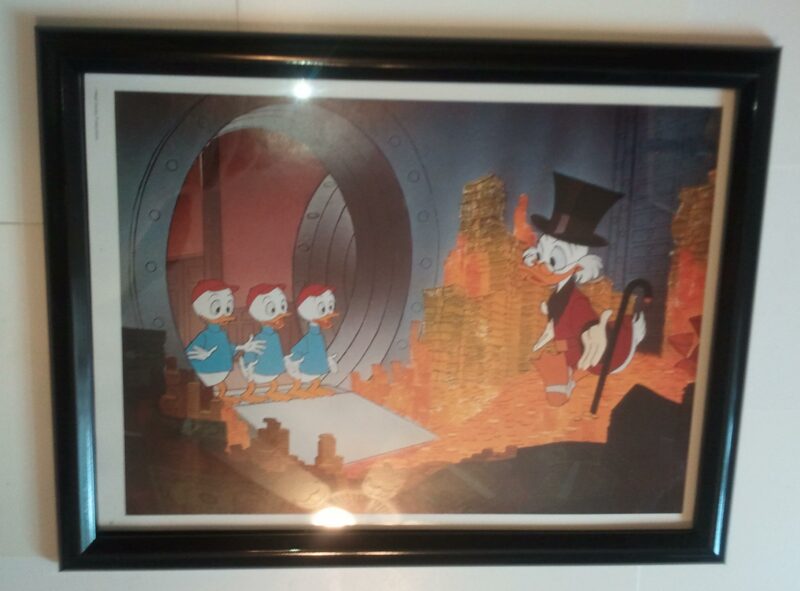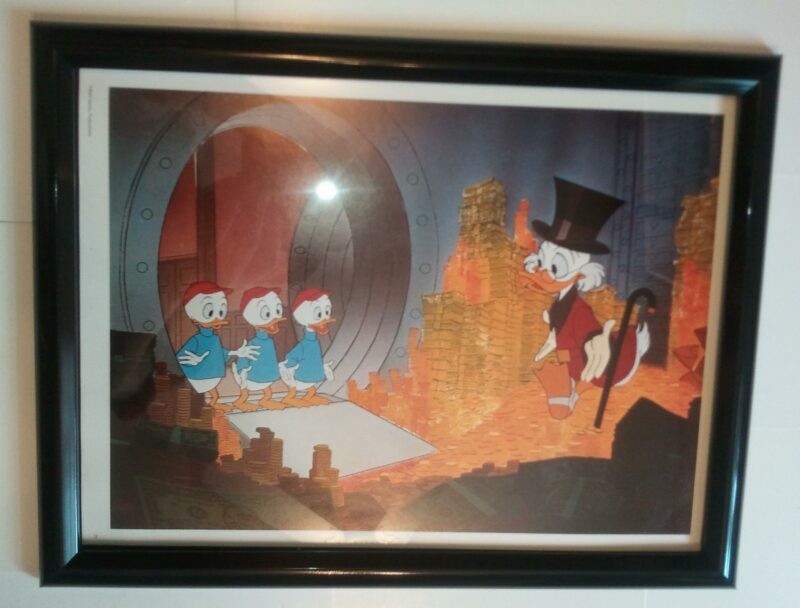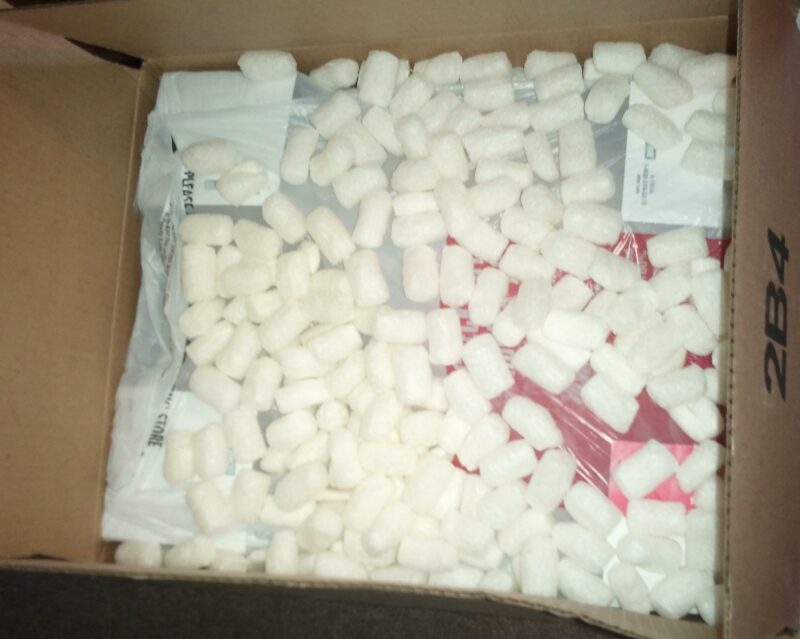Description
Scrooge’s first appearance in animated form (save for a brief cameo appearance on the Mickey Mouse Club television series) was in the 1967 theatrical featurette Scrooge McDuck and Money, in which he teaches his nephews some basic financial tips. In this featurette, Scrooge was voiced by Bill Thompson.
Scrooge McDuck is a cartoon character created in 1947 by Carl Barks and licensed by The Walt Disney Company. Scrooge is an elderly Scottish anthropomorphic Pekin Duck with a yellow-orange bill, legs, and feet. He typically wears a red or blue frock coat, top hat, pince-nez glasses, and spats and is portrayed in animations as speaking with a slight Scottish accent, also sometimes known as a Scottish burr. His dominant character trait is his thrift, and within the context of the fictional Disney universe, he is the world’s richest person.
Named after Ebenezer Scrooge from the 1843 novel A Christmas Carol, Scrooge is a wealthy Scottish business magnate and tycoon. He was in his first few appearances characterized as a greedy miser and antihero (as Charles Dickens’ original Scrooge was), but in later comics and animated shorts and the modern day he is more often portrayed as a charitable and thrifty hero, adventurer, explorer and philanthropist. Scrooge was created by Barks as a comic book character originally as an antagonist for Donald Duck, first appearing in the 1947 Four Color story “Christmas on Bear Mountain” (#178). The character soon became so popular that McDuck became a major figure of the Duck universe. In 1952 he was given his own comic book series, called Uncle Scrooge, which still runs today. Scrooge was most famously drawn by his creator Carl Barks, and later by Don Rosa. Comics have remained Scrooge’s primary medium, although he has also appeared in animated cartoons, most extensively in the television series DuckTales (1987–1990).
Along with several other characters in the Disney franchise, Scrooge has enjoyed international popularity, particularly in Europe, and books about him are frequently translated into other languages. He is the maternal uncle of Donald Duck, the grand-uncle of Huey, Dewey and Louie, and a usual financial backer of Gyro Gearloose. His “money bin” and indeed Scrooge himself are often used as humorous metonyms for great wealth in popular culture around the world.
One possible inspiration is an unnamed character in the 1943 Donald Duck short film The Spirit of ’43 who was a representation of Donald’s thrifty conscience. This anonymous character had many of Scrooge’s characteristics including sideburns, pince-nez glasses, and a Scottish accent.
Scrooge McDuck, maternal uncle of previously established character Donald Duck, made his first named appearance in the story Christmas on Bear Mountain which was published in Dell’s Four Color Comics #178, December 1947, written and drawn by artist Carl Barks. His appearance may have been based on a similar-looking, nameless Scottish character from the 1943 propaganda short The Spirit of ’43.
Scrooge had worked his way up the financial ladder from humble immigrant roots. Firstly, he took up a job polishing and shining boots, and was enraged when a ditchdigger paid him with an 1875 US dime, which was useless as currency in 19th century Glasgow. However, the coin inspired him to take a position as cabin boy on a Clyde cattle ship to the United States to make his fortune at the age of 13. In 1898, after many adventures he finally ended up in Klondike. There he found a golden rock the size of a goose’s egg. The next year he had made his first $1,000,000 and bought the deed for Killmule Hill from Casey Coot, the son of Clinton Coot and grandson of Cornelius Coot. He finally ended up in Duckburg in 1902. After some dramatic events where he faced both the Beagle Boys and president Roosevelt and his “Rough Riders” at the same time, he tore down the rest of the old fort Duckburg and raised his famous Money Bin at the same site. In the years to follow, Uncle Scrooge traveled all around the world in order to increase his fortune. During these and earlier travels he learned many different languages from all parts of the world. Meanwhile his family ran the Money Bin. When Scrooge finally returned to Duckburg, he found himself the richest duck in the world, rivaled only by Flintheart Glomgold, John D. Rockerduck and, less prominently, the maharaja of the fictional country Howdoyoustan (play on Hindustan). He had however changed. His newly developed personality – one that was a mix of hostility and crankiness made his own family leave him. 12 years later, he closed his empire down, but eventually returned to a public life 5 years later and started his business.
He keeps a portion of his wealth, money he has personally earned himself, in a massive Money Bin overlooking the city of Duckburg. In the short Scrooge McDuck and Money, he remarks to his nephews that this money is “just petty cash”.
A shrewd businessduck and noted tightwad, he is fond of diving into his money, burrowing through it, swimming laps in it, spitting out coins that enter his mouth like water during these swimming sessions, and tossing coins into the air mirthfully only to let them fall upon his head — all without injury.
The sum of Scrooge’s wealth is unclear. According to Barks’ The Second Richest Duck as noted by a TIME article, Scrooge is worth one multiplujillion, nine obsquatumatillion, six hundred twenty-three dollars and sixty-two cents. In the DuckTales episode “Liquid Assets”, Fenton Crackshell (Scrooge’s accountant) notes that McDuck’s money bin contains 607 tillion 386 zillion 947 trillion 522 billion dollars and 36 cents. Don Rosa’s Life and Times of Scrooge McDuck notes that Scrooge amounts to five multiplujillion, nine impossibidillion, seven fantasticatrillion dollars and sixteen cents. A thought bubble from Scrooge McDuck sitting in his car with his Chauffeur in Walt Disney’s Christmas Parade No.1 (Published in 1949) that takes place in the story “Letter to Santa” clearly states “What’s the use of having eleven octillion dollars if I don’t make a big noise about it?” Forbes has occasionally tried to estimate McDuck’s wealth in real terms; in 2007, Forbes estimated his wealth at $28.8 billion; in 2011, it rose to $44.1 billion due to the rise in gold prices. One website used the size of Scrooge’s Money Bin as a basis and calculated that it could contain over $27 trillion. Barks himself has said that the fortune is five billion quintiplitilion unptuplatillion multuplatillion impossibidillion fantasticatrillion dollars. Whatever the amount, Scrooge never considers it to be enough; he believes that he has to continue to earn money by any means possible. A running gag is Scrooge always making profit on any business deal.
Scrooge’s biggest role outside of comics would come in the 1987 animated series DuckTales, a series loosely based on Carl Barks’s comics, and where Alan Young returned to voice his character. In this series, premiered over two-hours on September 18, 1987, while the regular episodes began three days later, Scrooge becomes caretaker of Huey, Dewey and Louie when Donald joins the United States Navy. Scrooge’s DuckTales persona is considerably softer than in most previous appearances; his ruthlessness is played down considerably and his often abrasive personality is reduced in many episodes to that of a crotchety but lovable old uncle. Still, there are flashes of Barks’ Scrooge to be seen, particularly in early episodes of the first season. After the series Scrooge also appeared in DuckTales the Movie: Treasure of the Lost Lamp.
Scrooge also makes an appearance in Disney’s and Square Enix’s Kingdom Hearts series, in a role where he helps Mickey Mouse set up a world transit system. He first appears in Kingdom Hearts II as a minor non-playable character in Hollow Bastion, where he is trying to recreate his favorite ice cream flavor – sea-salt. Scrooge later appears in the prequel, Kingdom Hearts: Birth by Sleep, this time with a speaking role. He’s working on establishing an ice-cream business in Radiant Garden and gives Ventus three passes to the Dream Festival in Disney Town. Young reprises the role in the English version of Birth by Sleep.
Huey, Dewey, and Louie Duck are triplet cartoon characters created in 1937 by writer Ted Osborne and cartoonist Al Taliaferro, and are licensed by The Walt Disney Company. Huey, Dewey, and Louie are the nephews of Donald Duck and the grandnephews of Scrooge McDuck. Like their uncles, the boys are anthropomorphic white ducks with yellow-orange beaks and feet. They typically wear shirts with colorful baseball caps which are sometimes used to differentiate between them. The characters have made several animated appearances in both films and television, but comics remain their primary medium. The trio are the 11th, 12th, and 13th most published comic book characters in the world, and outside of the superhero genre, second only to Donald.
While the boys were originally created as mischief-makers to provoke their uncle’s famous temper, later appearances showed them to be valuable assets to their uncles on their adventures. All three of the boys are members of the fictional scouting organization, The Junior Woodchucks.
Huey, Dewey, and Louie were the idea of Al Taliaferro, the artist for the Silly Symphonies comic strip, which featured Donald Duck. The Walt Disney Productions Story Dept. on February 5, 1937, sent Taliaferro a memo recognizing him as the source of the idea for the planned short, Donald’s Nephews. The nephews debuted in Taliaferro’s comic strip, which by this time had been renamed Donald Duck, on Sunday, October 17, 1937, beating the theatrical release of Donald’s Nephews by almost six months. The names were devised by Disney gag man Dana Coty, who took them from Huey Long, Thomas Dewey, and Louis Schmitt, an animator at the Disney Studio in the 1930s and 1940s. Taliaferro’s introduction of the nephews emulated the three nephews in the Happy Hooligan comic strip and was also influenced by Mickey Mouse’s nephews, Morty and Ferdie Fieldmouse.
Huey, Dewey, and Louie are the sons of Donald’s sister Della Duck; in Donald’s Nephews, their mother is instead named Dumbella. In the original theatrical shorts, they were originally sent to visit Donald for only one day; in the comics, the three were sent to stay with Donald on a temporary basis, until their father came back from the hospital (the boys ended up sending him there after a practical joke of putting firecrackers under his chair). According to a published Duck family tree, their full names are Huebert, Deuteronomy and Louis. In both the comics and animated shorts, the boys’ parents were never heard from or mentioned again after these instances, with the boys ending up permanently living with Donald. All four of them live in the fictional city of Duckburg, in the fictional state of Calisota.
The three ducklings are noted for their identical appearances and personalities. A running joke involves the three sometimes even finishing each other’s sentences. In the theatrical shorts, Huey, Dewey, and Louie often behave in a rambunctious manner, sometimes committing retaliation or revenge on their uncle Donald Duck. In the comics, however, as developed by Al Taliaferro and Carl Barks, the young ducks are more usually portrayed as well-behaved, preferring to assist their uncle Donald Duck and great-uncle Scrooge McDuck in the adventure at hand. In the early Barks comics, the ducklings were still wild and unruly, but their character improved considerably due to their membership in the Junior Woodchucks and the good influence of their wise old great-grandmother Elvira Coot “Grandma” Duck.
In the 1988 film Who Framed Roger Rabbit, Huey, Dewey, and Louie appear in a picture on a newspaper in Eddie Valiant’s office. They also make a cameo in Mickey’s Christmas Carol. Clarence Nash, Donald’s voice actor, gave the voices to the boys in the cartoon shorts, making them just as unintelligible as Donald’s. Huey, Dewey, and Louie were all voiced by Russi Taylor in DuckTales.
In Kingdom Hearts they work in the item shop in the First District of Traverse Town. In Kingdom Hearts II, they individually run an item shop (Huey), a weapon shop (Louie), and an accessory shop (Dewey) in Hollow Bastion/Radiant Garden. In both endings, they are all seen going back to Disney Castle. They reappear in Kingdom Hearts: Birth By Sleep in Disney Town, recreating Ice Cream flavors, this time with a speaking role.
This item may or may not show a tiny number on the image…please inspect the pictures carefully.
Frame is shrinkwrapped until time of purchase. Ships boxed with packing peanuts.
THE PERFECT GIFT!
Related products
-
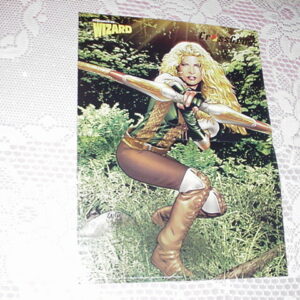
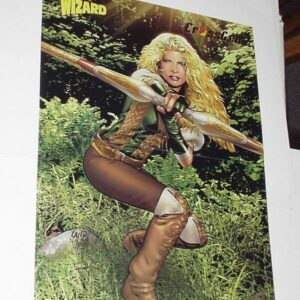
CrossGen Poster #18 Arwyn Greg Land Sojourn Bow of Ayden
$29.99 Add to cart -
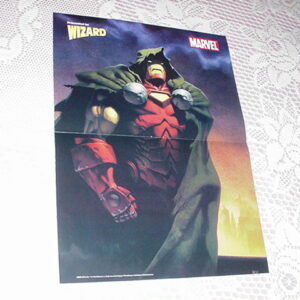
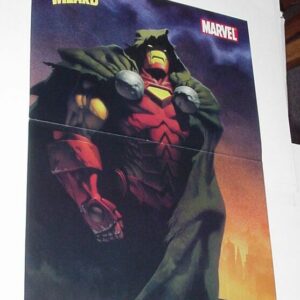
Iron Man Poster # 5 by Kev Walker Iron Doom Exiles 23 Cover
$29.99 Add to cart -
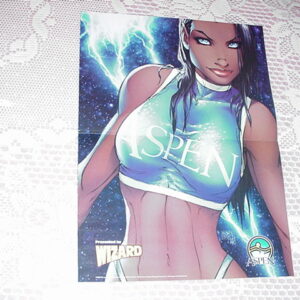
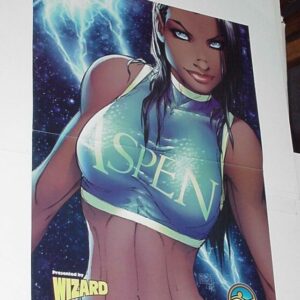
Fathom Poster # 9 Aspen Shirt Michael Turner Matthews Superman
$39.99 Add to cart -
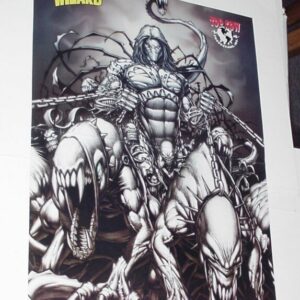
Darkness Poster # 4 Dale Keown Darklings in Chains Pitt Hulk
$29.99 Add to cart

